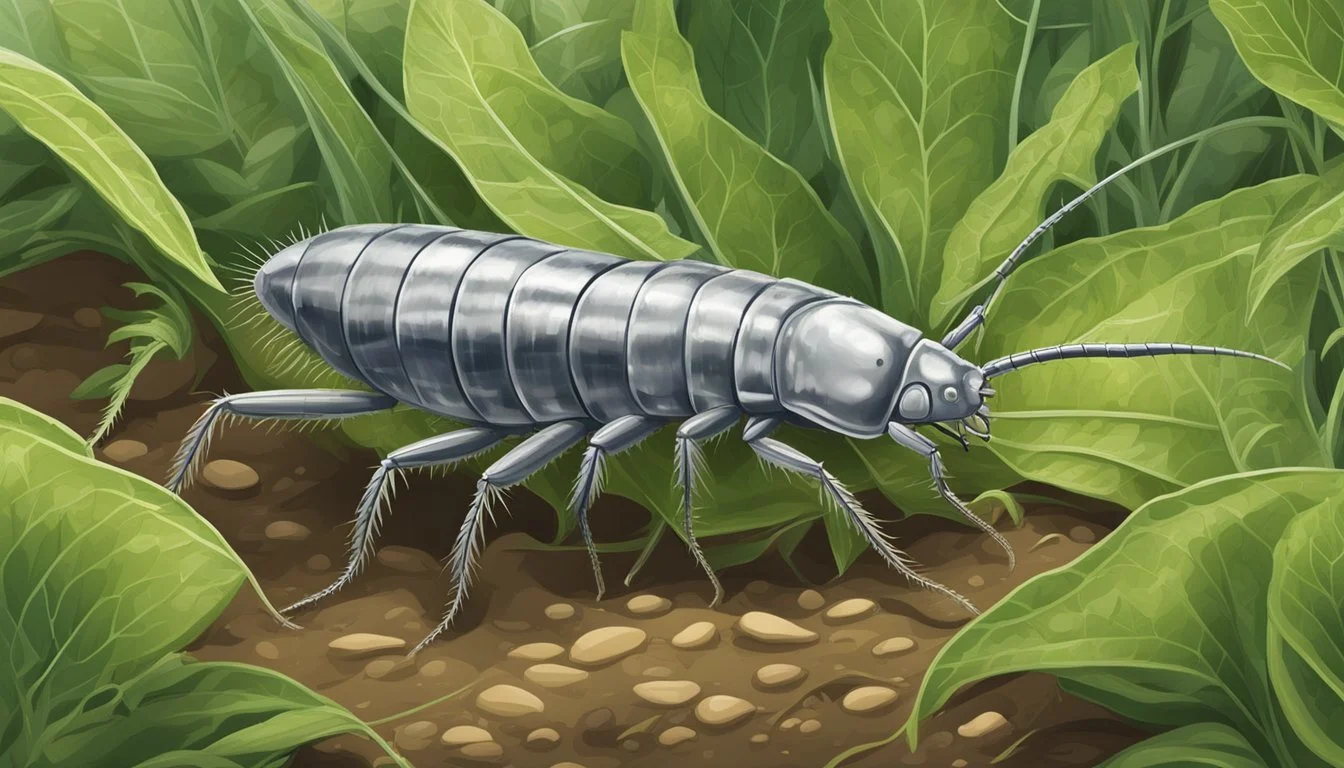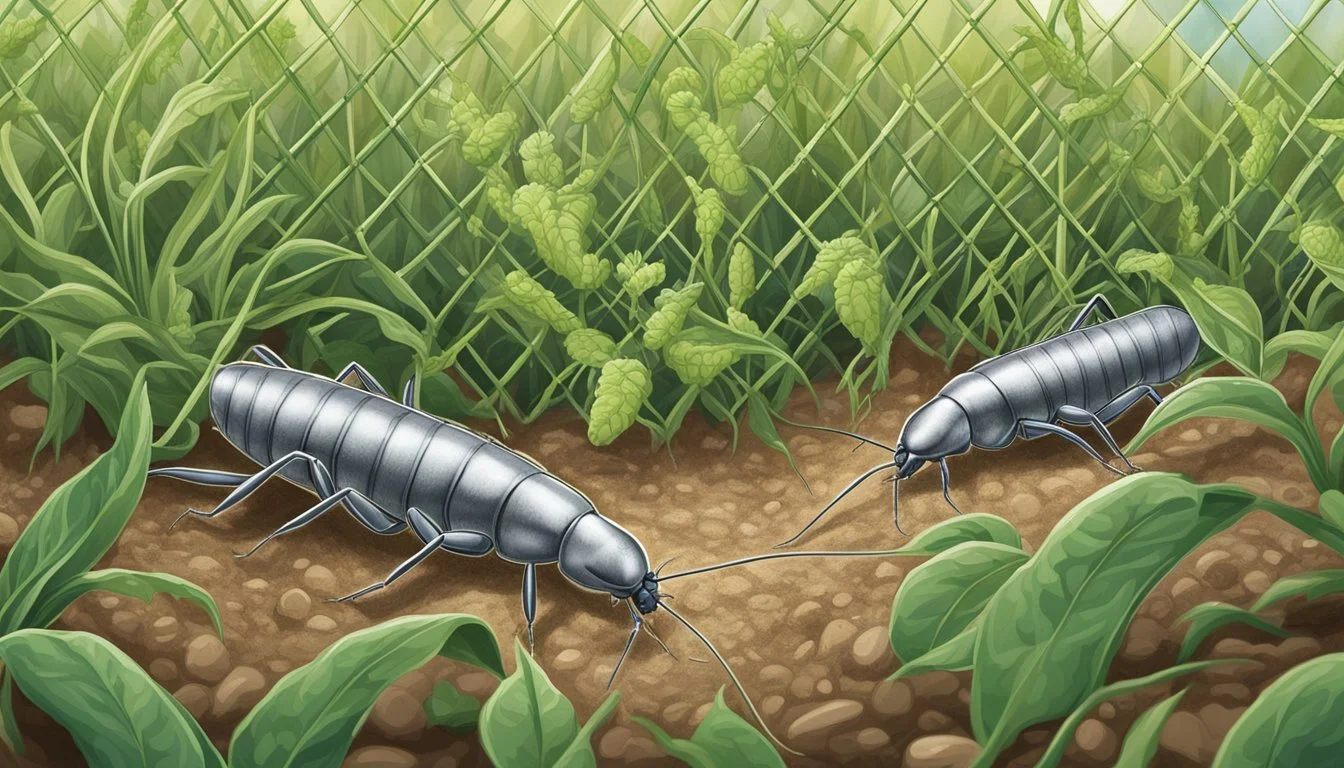Protecting Crops from Silverfish
Effective Strategies for Farmers
Silverfish pose a unique challenge to agriculturalists aiming to protect their crops from these voracious pests. These small, wingless insects thrive in damp environments and can cause extensive damage to stored grains and cereals. With a preference for carbohydrates such as sugars and starches, silverfish can quickly become a nuisance in agricultural storage facilities where they feed on cereals, moist wheat flour, and sometimes even damage paper wrappings and labels, misguiding inventory management and contaminating produce.
Effective management of silverfish in crop storage involves a multi-faceted approach. First, farmers must ensure ideal storage conditions, keeping humidity levels low as silverfish thrive in moisture-rich areas. The implementation of natural deterrents, such as cedarwood, can help in keeping these pests at bay. Agriculturalists also resort to meticulous cleaning routines to remove food sources and potential silverfish eggs. Sealing any cracks and crevices in storage facilities prevents their entry and fortifies the defense against infestation.
Regular monitoring for signs of silverfish activity is crucial for timely intervention. Although silverfish do not carry diseases, their presence indicates high humidity that could spoil crops and attract other pests. Hence, understanding silverfish behavior and habitat preferences is key to preemptively controlling their populations and safeguarding one's harvest from their unwelcome appetite.
Understanding Silverfish
Before investing in crop protection strategies, it's crucial to understand the biology and habitual patterns of silverfish. These insects are not just household nuisances but can threaten the integrity of stored crops in various environments prone to humidity.
Biology and Habits of Silverfish
Silverfish (Lepisma saccharina) are small, wingless insects known for their distinct, fish-like appearance and movements. They are characterized by a silvery-gray color and a tapered, elongated body measuring about ½ to 1 inch in length. As nocturnal pests, silverfish seek food sources at night, which include carbohydrates such as sugars and starches found in paper, glue, and certain textiles.
Diet: Carbohydrates (e.g., paper, glue, textiles)
Appearance: Silvery-gray, elongated body
Activity: Nocturnal
Reproduction: Lays up to 60 eggs at a time
Common Habitats: Basements, Attics, and Bathrooms
Silverfish thrive in dark, damp, and humid environments. They frequently inhabit spaces such as basements, attics, and bathrooms where the humidity levels are high. These areas offer silverfish ample food sources and a conducive environment for reproduction, making them common sites for potential infestations.
Preferred Environments:
Basements: Often damp and undisturbed
Attics: Provides darkness and seclusion
Bathrooms: Consistent humidity levels
Identifying a Silverfish Infestation
Detecting a silverfish infestation requires vigilance. Signs include small holes, yellowish stains, or feces that appear as tiny black pepper-like specks on infested materials. Closets storing seasonal clothing and linens can also be targeted by these pests due to the presence of starches and natural fibers.
Infestation Indicators:
Damage: Small holes in paper or fabric
Stains: Yellowish markings near feeding areas
Feces: Black pepper-like specks
By recognizing the behavioral patterns and preferred habitats of silverfish, one can implement targeted measures to safeguard crops and prevent extensive damage caused by these persistent pests.
Preventive Measures
Effectively protecting crops from silverfish hinges on creating an unfavorable environment for these pests. The following preventive strategies are critical in safeguarding agricultural storage and production areas against silverfish infestations.
Minimizing Humidity and Moisture
Silverfish thrive in humid areas, so maintaining a dry environment is essential for prevention. Employing a dehumidifier in damp spaces significantly reduces moisture, which is less inviting to silverfish. Regular checks for leaks and ensuring proper ventilation can prevent the accumulation of moisture, which silverfish find appealing.
Sealing Cracks and Crevices
To prevent silverfish from entering storage or crop areas, it is important to seal any cracks and crevices in the walls, floors, and foundations. Use caulking or other appropriate materials to close off potential entry points. Regular inspections for new cracks will reinforce prevention efforts and maintain a secure environment.
Proper Storage Practices
Storing crops correctly plays a vital role in silverfish control. They are known for their destructive feeding habits, especially on materials found in a typical pantry. Utilizing airtight containers for crop storage can deter silverfish, as they prefer to access items with ease. Regularly vacuum storage areas to remove food particles, and keep items in tight containers to reduce the chances of infestation.
Direct Control Methods
When it comes to protecting crops from silverfish, there are a variety of direct control methods available. These can be broadly categorized into chemical treatments, non-chemical treatments, and methods involving professional pest management.
Chemical Treatments
Chemical treatments often involve the application of insecticides that are toxic to silverfish. One of the most effective chemical options is boric acid, a substance that is poisonous to many pests and can kill silverfish upon contact. It's important to apply the boric acid in areas where silverfish frequent, but away from places that pets or children can access. Another chemical option is pyrethrin, an insecticide that can be used to directly spray on or around infested areas to target silverfish. Propoxur is yet another insecticide that has been shown to be effective against silverfish, but it must be used with caution due to its toxic nature.
Boric Acid: Apply in nooks and crevices away from non-targets.
Pyrethrin: Directly spray on infested areas.
Propoxur: Use with caution, effective against pests.
Non-Chemical Treatments
For those looking for alternatives to chemical insecticides, non-chemical treatments are a viable option. Diatomaceous earth is a non-toxic substance that can be spread in areas where silverfish are found. It works mechanically by damaging the exoskeletons of silverfish, leading to dehydration and death. Reducing clutter can also deter silverfish, as it removes their preferred hiding spots and breeding grounds. Regularly cleaning and vacuuming can help to minimize clutter and remove any belongings that silverfish might damage or lay eggs in.
Diatomaceous Earth: Distribute in areas where silverfish are present.
Clutter Reduction: Keep areas clean and uncluttered.
Professional Pest Management
When infestations are severe or when homeowners prefer not to handle pesticides themselves, professional pest management can be the most effective route. Pest management professionals, sometimes referred to as exterminators, have access to a range of potent chemical and non-chemical methods that are not available to the general public. They can safely apply more toxic treatments, ensuring that the job is done effectively while minimizing risks. Additionally, professional pest control experts can provide advice and ongoing pest management services to prevent future infestations.
Exterminators: Hire for severe infestations and safe application of toxic treatments.
Professional Pest Control: Seek expert advice and long-term management solutions.
Damage and Impact of Silverfish
Silverfish can inflict notable damage on household items, particularly those containing paper, starch, and sugar. They are known for their destructive feeding habits which not only cause a nuisance but can also lead to economic losses.
Effects on Personal Items
Silverfish are pests that have a propensity for consuming organic materials found in various household items. They often target paper products, such as books and documents, leaving behind holes and notches that compromise the integrity of these possessions. Similarly, items like wallpaper, book bindings, and photographs are at risk due to the glue that silverfish find palatable. Clothing made from natural fibers like silk and cotton can also suffer damage, as silverfish are drawn to the starch contained within the fabrics.
Potential Health Threats
While silverfish do not directly harm humans, their presence can indirectly influence health. They sometimes infest food items such as flour, cereals, and sugar, leading to contamination. Consuming food that has been infested by silverfish can result in the ingestion of their eggs and shed skins, posing a potential health risk.
Economic Implications
The economic impact of a silverfish infestation can be significant. They can damage not only personal belongings but also structural elements of homes like baseboards and carpeting. This can lead to costly repairs and replacements. In commercial settings, such as libraries or stores with paper goods and textiles, the economic repercussions of silverfish damage can escalate due to the potential need for widespread pest control measures and inventory loss.
Natural Repellents and DIY Solutions
When it comes to protecting crops from silverfish, homeowners and gardeners can take advantage of a variety of natural repellents and DIY solutions that are safe and effective. These methods often involve the use of common household items and readily available essential oils and herbs.
Home Remedies for Silverfish Control
Mold Management: As silverfish thrive in damp, mold-prone environments, controlling mold is a crucial step in deterring these pests. Simple practices such as reducing humidity with dehumidifiers and ensuring proper ventilation can create unfavorable conditions for silverfish.
DIY Traps:
Pet-Safe Sticky Trap: Create a non-toxic trap using a shoebox lined with double-sided tape and a quarter-sized hole in each end. Placing a small piece of bread inside acts as bait, attracting silverfish to a sticky demise. Position the trap in known silverfish hotspots and check it after a few days.
Natural Ingredients:
Food Supply Interruption: Store any potential food sources for silverfish, such as flour or sugar, in airtight containers to cut off their access.
Diatomaceous Earth (DE): Sprinkle a fine layer of food-grade DE in silverfish-prone areas. The microscopic sharp edges of DE can be fatal to silverfish upon contact.
Using Essential Oils and Herbs
Cinnamon and Cloves: These aromatic spices are not only used for cooking, but they are also effective in repelling silverfish due to their strong scent. Small sachets filled with cinnamon sticks or cloves can be placed in cupboards and drawers to deter these pests.
Essential Oils: Several essential oils are known to repel silverfish, including lavender, peppermint, and citronella. A repellent spray can be created by mixing about 15 to 20 drops of an essential oil of choice with a cup of water. This solution can be sprayed in areas where silverfish are commonly found.
Bay Leaves: Their distinct fragrance is unappealing to silverfish. Scatter whole bay leaves in areas where crops are stored or where silverfish activity has been observed to keep them at bay.
By incorporating these natural repellents and DIY solutions into their pest control strategy, individuals can effectively safeguard their crops from silverfish without relying on harsh chemicals.
Long-Term Strategies and Maintenance
Implementing effective long-term strategies and regular maintenance routines is crucial for the control of silverfish populations. Key elements include sustaining cleanliness, reducing excess moisture, and carrying out periodic inspections.
Regular Cleaning and Decluttering
Maintaining a clean environment is a primary defense against silverfish. They are drawn to debris and clutter, which provide optimal hiding spots. Regular cleaning schedules should include:
Vacuuming at least once a week to remove food particles and potential eggs.
Decluttering spaces, especially in storage areas like basements and attics.
Keeping storage areas well-organized and using plastic containers instead of cardboard boxes to reduce attractive nesting locations.
Monitoring and Regular Inspections
It's important to conduct regular inspections and monitoring to catch any potential infestations early. These inspections should focus on:
Humid areas, as silverfish thrive in environments with high humidity. Utilize dehumidifiers to reduce humidity levels.
Checking window frames, bookshelves, and laundry rooms thoroughly for signs of silverfish, such as their distinctive pepper-like feces or shed skins.
Following outlined instructions for the application of deterrents can help keep silverfish at bay and ensure they don't become a nuisance.
Selecting the Right Products and Tools
When protecting crops from silverfish, one must select specific insecticides and moisture control tools wisely, ensuring a blend of efficiency and safety for both the crops and the environment.
Choosing Effective Insecticides
The first line of defense in silverfish control involves choosing effective insecticides that are known to combat these pests. Two reliable options are:
Boric Acid: A naturally occurring compound that is lethal to silverfish but has low toxicity to humans and animals when used as directed. It can be sprinkled around the edges of fields as a barrier.
Diatomaceous Earth: This is a non-toxic powder made from the fossilized remains of diatoms. When sprinkled around crops, it works mechanically by injuring the exoskeletons of silverfish, leading to dehydration.
Silverfish are repelled and controlled using products such as Supreme IT, which serves as a barrier to prevent future infestations when applied according to manufacturer guidelines.
Deploying Dehumidifiers and Sealants
Creating an environment that is inhospitable to silverfish can largely contribute to crop protection. This is typically achieved through:
Dehumidifiers: These appliances reduce the humidity levels in enclosed spaces like greenhouses, making them less attractive to moisture-loving silverfish.
Sealants: Use of sealants for weather-stripping around doors and caulking cracks can significantly deter silverfish from entering crop storage areas. Barrier establishment is a key practice for keeping silverfish out, as recommended by various DIY pest control sources.
Implementing these methods can greatly aid in protecting crops from the damaging effects of silverfish. It is crucial to follow product instructions carefully and ensure regular maintenance for the most effective results.
Understanding Silverfish Behavior
Silverfish are persistent pests that pose threats to various household items through their feeding habits and ability to remain undetected for lengthy periods. An in-depth understanding of their behavioral patterns is central to safeguarding property effectively.
Feeding Preferences and Lifecycle
Silverfish have a diverse diet but exhibit a strong preference for materials rich in starch, protein, and sugar. Common targets include cardboard boxes, which they consume for the starch content. Within homes, they may also feed on a variety of debris, further showcasing their adaptability. In their pursuit of protein, items such as dried meat or even dead insects can serve as food sources for silverfish. Their lifecycle begins as a tiny egg, and they rapidly progress through several nymph stages before reaching adulthood, a process taking anywhere from three months to three years, depending on environmental conditions.
Silverfish Movements and Hideouts
Silverfish are quick, nocturnal insects that often go unnoticed due to their elusive nature. They are attracted to dark, damp environments where they can find their preferred food sources. Textiles such as fabrics and wool often fall victim to their feeding, especially when stored in moist locations. In the home environment, they find solace in bookcases, door frames, and behind curtains — places with ample cover and access to their food preferences. Silverfish are also known to consume caulking used in construction, seeking both sustenance and shelter. These pests require consistent vigilance as they can thrive on minimal sustenance such as pet food spills or residue found in seldom-cleaned areas.
Frequently Asked Questions
In addressing the challenge of silverfish on crops, various methods ranging from home remedies to preventive strategies are explored to ensure sustainable protection and control.
What are effective home remedies for controlling silverfish on crops?
Home remedies such as the application of diatomaceous earth around crops can effectively deter silverfish due to its abrasive properties that damage the pest's exoskeleton.
How do you create a DIY silverfish trap for agricultural use?
Creating a DIY trap involves using sticky traps or jars lined with masking tape and baited with starchy food or sugar to attract and capture silverfish on the farm.
What are the best natural predators of silverfish for crop protection?
Natural predators such as spiders and house centipedes can play a role in reducing silverfish populations in an agricultural setting, promoting a balanced ecosystem.
How can one permanently eliminate a silverfish infestation in farming areas?
Permanent elimination of silverfish infestations requires an integrated approach that includes regular cleaning to remove food sources, sealing off entry points, and maintaining low humidity around crops.
What substances are known to naturally repel silverfish from plants?
Substances such as cedarwood oil, which can be made into a natural repellent spray, are known to effectively repel silverfish from plants due to their aversion to the smell.
Can silverfish infestations in agricultural settings be prevented, and if so, how?
Preventing silverfish infestations involves maintaining dry conditions, employing adequate sanitation practices, and using barriers or repellents to create an unsuitable environment for silverfish to thrive.








